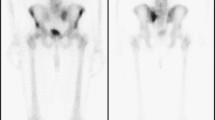Abstract
Objective
Bone metastases occur in ∼80% of patients with advanced cancer and cause significant morbidity. There are currently no established means by which to identify the early growth of micrometastatic cells or their effects on bone at a time when curative therapy might be initiated. We postulated that high-resolution magnetic resonance imaging (MRI) could detect and quantify the growth and destructive effects of bone micrometastases.
Design
Using a mouse model for metastasis of malignant melanoma, we have examined the ability of MRI to quantify cortical bone destruction and the percentage of the medullary cavity occupied by tumour, trabecular bone, and marrow. The results from MRI were compared to histomorphometry (the reference standard) and to radiographs.
Results
In vivo gradient-echo and spin-echo MRI demonstrated that metastatic melanoma replaced the marrow space but that the cortical bone integrity was preserved (P ≤ 0.001). The smallest detectable micrometastasis had an area of 0.323 mm2. In contrast, we observed no trends after quantifying the radiograph data.
Conclusion
These approaches delineated the limits of MRI in its ability to quantify tumour burden and the effect on bone in this model. Given the increasing use of MRI as a non-invasive clinical diagnostic method, the present findings may be applicable in detecting bone metastases in the clinical setting at an early and potentially treatable stage.




Similar content being viewed by others
References
Weber MH, Sharp JC, Hassard TH, Orr FW. Normal murine bone morphometry: a comparison of magnetic resonance microscopy with micro X-ray and histology. Skeletal Radiol 2002; 31: 282–291.
Gardner JR, Hess CP, Webb AG, Tsika RW, Dawson MJ, Gulani V. Magnetic resonance microscopy of morphological alterations in mouse trabecular bone structure under conditions of simulated microgravity. Magn Reson Med 2001; 45: 1122–1125.
Majumdar S, Newitt D, Jergas M, Gies A, Chiu E, Osman D, et al. Evaluation of technical factors affecting the quantification of trabecular bone structure using magnetic resonance imaging. Bone 1995; 17: 417–430.
Muller R, Koller B, Hildebrand T, Laib A, Gianolini S, Ruegsegger P. Resolution dependency of microstructural properties of cancellous bone based on three-dimensional mu-tomography. Technol Health Care 1996; 4: 113–119.
Hwang SN, Wehrli FW. Subvoxel processing: a method for reducing partial volume blurring with application to in vivo MR images of trabecular bone. Magn Reson Med 2002; 47: 948–957.
Weber MH, Sharp JC, Latta P, Sramek M, Hassard HT, Orr FW. Magnetic resonance imaging of trabecular and cortical bone in mice: comparison of high resolution in vivo and ex vivo MR images with corresponding histology. Eur J Radiol 2005; 53: 96–102.
Wan W, Wetmore L, Sorensen CM, Greenberg AH, Nance DM. Neural and biochemical mediators of endotoxin and stress-induced c-fos expression in the rat brain. Brain Res Bull 1994; 34: 7–14.
Starcukova J, Kozlowski P, Starcuk Z, Saunders JK, Germanus A, Thiele H. WIN-MRI: PC software for imaging and spectroscopic imaging data processing and presentation. [Proc. 1st.]. 1997. Krakow Winnipeg Workshop on biomedical applications of MRI and MRS.
Lee J, Weber M, Mejia S, Bone E, Watson P, Orr W. A matrix metalloproteinase inhibitor, batimastat, retards the development of osteolytic bone metastases by MDA-MB-231 human breast cancer cells in Balb C nu/nu mice. Eur J Cancer 2001; 37: 106–113.
Sanchez-Sweatman OH, Lee J, Orr FW, Singh G. Direct osteolysis induced by metastatic murine melanoma cells: role of matrix metalloproteinases. Eur J Cancer 1997; 33: 918–925.
Enochs WS, Petherick P, Bogdanova A, Mohr U, Weissleder R. Paramagnetic metal scavenging by melanin: MR imaging. Radiology 1997; 204: 417–423.
Engelke K, Majumdar S, Genant HK. Phantom studies simulating the impact of trabecular structure on marrow relaxation time, T2’. Magn Reson Med 1994; 31: 380–387.
Majumdar S, Genant HK. In vivo relationship between marrow T2* and trabecular bone density determined with a chemical shift-selective asymmetric spin-echo sequence. J Magn Reson Imaging 1992; 2: 209–219.
Majumdar S, Thomasson D, Shimakawa A, Genant HK. Quantitation of the susceptibility difference between trabecular bone and bone marrow: experimental studies. Magn Reson Med 1991; 22: 111–127.
Sebag GH, Moore SG. Effect of trabecular bone on the appearance of marrow in gradient-echo imaging of the appendicular skeleton. Radiology 1990; 174: 855–859.
Rybak LD, Rosenthal DI. Radiological imaging for the diagnosis of bone metastases. Q J Nucl Med 2001; 45: 53–64.
Hayward JL, Carbone PP, Heuson JC, Kumaoka S, Segaloff A, Rubens RD. Assessment of response to therapy in advanced breast cancer: a project of the Programme on Clinical Oncology of the International Union Against Cancer, Geneva, Switzerland. Cancer 1977; 39: 1289–1294.
Acknowledgements
We thank David Eisenstat for the use of his microscope and digital camera. The cost of the research has been made possible through a grant to F.W.O. and J.C.S. from the National Science and Engineering Research Council of Canada and to M.H.W. from the Canadian Institutes for Health Research.
Author information
Authors and Affiliations
Corresponding author
Rights and permissions
About this article
Cite this article
Weber, M.H., Sharp, J.C., Latta, P. et al. Early detection and quantification of murine melanoma bone metastases with magnetic resonance imaging. Skeletal Radiol 36, 659–666 (2007). https://doi.org/10.1007/s00256-007-0283-9
Received:
Revised:
Accepted:
Published:
Issue Date:
DOI: https://doi.org/10.1007/s00256-007-0283-9




